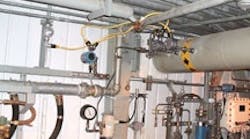The Alaskan North Slope may not be "the end of the world," but it is a cold and isolated place where workers face unusual challenges from the beautiful, but harsh environment. Many work 12-hour shifts, seven days a week, and anything that can be done to make their work routines easier is greatly appreciated.
At the northern terminus of the Trans Alaska Pipeline (TAPS) Alyeska Pipeline Service Co. operates Pump Station No. 1 where it measures and takes custody of about 1 million barrels of oil each day. Alyeska's goal is to measure accurately the inflow of crude oil, a task complicated by the fact that each stream comes in through each line at different pressures, temperatures and specific gravities.
API Certified
Alyeska observes a number of requirements for custody transfer metering instrumentation that meet American Petroleum Institute (API) standards. For example, Alyeska annually certifies the accuracy of some 53 temperature transmitters and their temperature-sensing elements (RTDs) throughout the facility. Each transmitter and RTD must be removed from the field, and calibrated in a controlled environment.
The original transmitters were installed using rigid conduit, some with, and some without explosion-proof flex connections. Later installations used mineral-insulated cable but, like the rigid conduit, it was prone to damage in spite of its flexibility.
To remove transmitters for annual certifications, technicians had to loosen screws from terminals, remove the lugs, and pull wires through fittings and transmitter housings. Threads were easily stripped, and electrical shorts from damaged wires were fairly common. Both the manual connections and the rigidity of the wiring made the transmitter calibration/certification procedure difficult and time consuming.
Armored, Flexible Connections
To quickly remove and reinstall the temperature transmitters and RTDs without damaging the wiring, Alyeska’s technicians installed flexible, multi-conductor plastic-encased and armored InterlinkBT cordsets made by Turck, Inc. These cables and terminations are instrument tray cable rated and have locking devices that conform to the requirements of Class 1 Div 2 hazardous areas (Figure 1).
Figure 1: Well-Connected Field DevicesWherever field devices are serviced or calibrated
frequently, quick connects and flexible cordsets are
there to speed the process.
Because Alyeska has both standard 4-20 mA DC analog and digital devices, it was also important to use cables suited for both, and have the ability to differentiate between them. This was accomplished with colored-coded cables and mated plugs and receptacles, design elements that made it virtually impossible to plug a cable into the wrong place.
Labor Intensive Task
Alyeska requirements specify a primary thermowell plus a second, separate verification thermowell in each custody transfer temperature measurement location. This redundant system is necessary to assure that accurate measurement of the temperature of the incoming crude that is important to the calculation of the volume of oil received is not lost. Originally, readings from the secondary RTDs at each producer skid were checked daily during meter proving by an operator in the field using a handheld monitor. These readings were then compared with the number continuously transmitted from the primary transmitter and RTD on the end device in the control room. Finding a more accurate and effective but less labor-intensive means of comparing the two temperature readings became another objective.
For existing locations, the solution called for installing single enclosures containing two transmitters that could take readings from more than one RTD element. Rosemount transmitters were used to receive input from both the primary and secondary RTDs in one instrument. Alyeska relied on another Turck solution--a multi-conductor "T" connector (Figure 2). This enabled cables from the two RTDs to be plugged into the dual transmitter housing. This connector allowed Alyeska to eliminate the handheld temperature monitors and incorporate another, more accurate transmitter. Readings from the two RTDs are alternately displayed and compared at the transmitter, and observers are informed instantly if a significant variation exists.
Figure 2: Fitting to a "T"
Multi-conductor "T" connectors helped
Alyeska engineers eliminate a manual
temperature reading and boost
the procedure's accuracy.
All analog and fieldbus temperature transmitters are now been equipped with these plug-in cordsets. When the instruments are due for calibration, a technician can quickly unplug the transmitter and RTD without damaging cables or connectors. Following calibration, the instruments are easily reinstalled.
With flexible quick-disconnect cordsets installed on all temperature transmitters proving the application, Alyeska now favors using them wherever devices are frequently removed for calibration or maintenance such as turbine meter spool pieces, which require service several times a year.
Dennis Hall is Lead Metering Technician at Alyeska Pipeline Service Company’s Pump Station No. 1 in Prudhoe Bay, Alaska.



